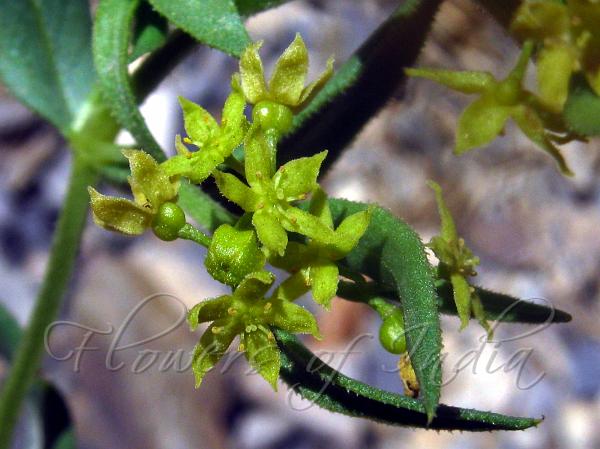|
| Tibetan Madder |
|

|

| File size | 671642 |
| Original date | 8/4/14 10:53 AM |
| Resolution | 2048 x 1536 |
| Flash | Flash did not fire, auto |
| Focal length | 6.6mm |
| Exposure time | 1/2000s |
| Aperture | 4.5 |
| Focus Distance | |
| Metering Mode | Center weighted average |
| Camera make | Canon |
| Camera model | Canon PowerShot A495 |
| Sensor type | OneChipColorArea |
|
|
|
|
Photo: |
Botanical name: Rubia tibetica Family: Rubiaceae (Coffee family)
Synonyms: Rubia transalaica
Synonyms: Rubia transalaica
Tibetan Madder is a perennial, erect herb, forming
loose cushions from a massive woody rootstock. Stems are up to 0.3 m,
quadrangular, smooth or hairy. Lower nodes are usually shortly sheathed
with membranous bases of old leaves. Leaves are opposite, and with
interpetiolar and leaflike stipules, in whorls of 4-6, stalkless or
nearly so, blade drying leathery, broadly to narrowly ovate, elliptic,
elliptic-oblong, or lanceshaped, 1-3 x 0.3-1.5 cm, both surfaces hairy
to hairless, base acute to obtuse. Principal vein is 1, sometimes with
2 weak lateral veins. Flowers are borne in a leafy and bracteose
inflorescence, with 1- to few-flowered cymes, in leaf axils and branch
ends. Flower-stalks are 4-6 mm. Ovary is 0.8-1.2 mm, sometimes
hirtellous. Flowers are yellow, flat, 5-8 mm in diameter, outside
sometimes rough, fused base about 0.5 mm, petals lanceshaped or
lanceshaped-ovate, 2-2.5 mm, long-pointed. Fruit is a berry 3-4 mm in
diameter. Tibetan Madder is found in the Himalayas, from Afghanistan to
Kashmir, Lahaul and Tibet, at altitudes of 2000-4400 m. Flowering:
June-July.
| Identification credit: Krishan Lal | Photographed in Sarchu, Lahaul, Himachal Pradesh. |
• Is this flower misidentified? If yes,